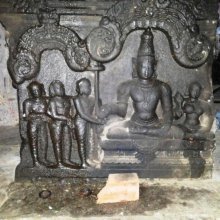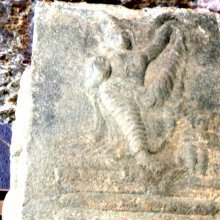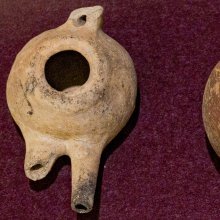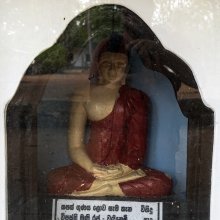Tana, Tāṇa, Tāṉā, Ṭāṅa: 27 definitions
Introduction:
Tana means something in Buddhism, Pali, Hinduism, Sanskrit, Jainism, Prakrit, the history of ancient India, Marathi, Hindi, biology, Tamil. If you want to know the exact meaning, history, etymology or English translation of this term then check out the descriptions on this page. Add your comment or reference to a book if you want to contribute to this summary article.
Alternative spellings of this word include Taan.
Images (photo gallery)
(+9 more images available)
In Hinduism
Natyashastra (theatrics and dramaturgy)
Source: archive.org: The Ragas Of Karnatic MusicTāna (तान).—Bharata calculates the number of tānas (which at his time are understood as names for grouping of svaras by permutation) which are derived from mūrchanās.
The tānakriyā or “the production of the tāna” on the string is of two kinds, viz.,
- praveśa (by the pulling of the lower note and the smoothening of the higher note),
- nigraha (by not touching).
Tāna as applied to this kriyā shifts the reference from the grouping of the notes in prastāra to the quality and peculiarity of the tone produced.
Source: archive.org: Natya ShastraTāna (तान).—The tānas depend on mūrchanās (melody) are eighty-four in number. Among these the hexatonic (ṣāḍava) ones are forty-nine, and the pentatonic (auḍavita) ones thirty-five.
The hexatonic tānas have seven varieties, e.g. four tānas devoid of Ṣaḍja, Ṛṣabha, Niṣāda and Pañcama in the ṣaḍja-grāma; three tānas devoid of Ṣaḍja, Ṛṣabha and Gāndhāra in the madhyama-grāma. Thus these being worked in all, the mūrchanās in the two grāmas will give rise to forty-nine tānas.
The pentatonic tānas have five varieties e.g. three tānas devoid of Ṣaḍja and Pañcama, of Ṛṣabha and Pañcama, and of Gāndhāra and Niṣāda in the ṣaḍja-grāma, two tānas devoid of Ṛṣabha and Dhaivata, and of Gāndhāra and Niṣāda in the madhyama-grāma. Thus these being worked in all, the pentatonic mūrchanās in the two grāmas will give rise to thirty-five tānas.

Natyashastra (नाट्यशास्त्र, nāṭyaśāstra) refers to both the ancient Indian tradition (shastra) of performing arts, (natya—theatrics, drama, dance, music), as well as the name of a Sanskrit work dealing with these subjects. It also teaches the rules for composing Dramatic plays (nataka), construction and performance of Theater, and Poetic works (kavya).
Vyakarana (Sanskrit grammar)
Source: Wikisource: A dictionary of Sanskrit grammar1) Tana (तन).—Personal ending for त (ta) of the second pers. pl. Parasmaipada in the imperative in Vedic Literature e.g जुजुष्टन (jujuṣṭana) for जुषत (juṣata) cf. Kas. On P VII. 1.45;
2) Tana.—tad. affixes टयु (ṭayu) and टयुल् (ṭayul) i.e. अन (ana) which, with the augment त् (t), in effect becomes तन (tana) e.g. सायंतन, चिरंतन (sāyaṃtana, ciraṃtana), etc.: cf. P. IV. 3.23.
--- OR ---
Tāna (तान).—One uniform accent or tone एकश्रुति (ekaśruti), as observed at the time of sacrifices in the case of the recital of the hymns; cf. तानलक्षणमेकं स्वरमाहु-र्यज्ञकर्मणि (tānalakṣaṇamekaṃ svaramāhu-ryajñakarmaṇi) V. Pr. I.130; cf. also P.I. 2.34.

Vyakarana (व्याकरण, vyākaraṇa) refers to Sanskrit grammar and represents one of the six additional sciences (vedanga) to be studied along with the Vedas. Vyakarana concerns itself with the rules of Sanskrit grammar and linguistic analysis in order to establish the correct context of words and sentences.
Ganitashastra (Mathematics and Algebra)
Source: archive.org: Hindu MathematicsTāna (तान) represents the number 49 (forty-nine) in the “word-numeral system” (bhūtasaṃkhyā), which was used in Sanskrit texts dealing with astronomy, mathematics, metrics, as well as in the dates of inscriptions and manuscripts in ancient Indian literature.—A system of expressing numbers by means of words arranged as in the place-value notation was developed and perfected in India in the early centuries of the Christian era. In this system the numerals [e.g., 49—tāna] are expressed by names of things, beings or concepts, which, naturally or in accordance with the teaching of the Śāstras, connote numbers.

Ganitashastra (शिल्पशास्त्र, gaṇitaśāstra) refers to the ancient Indian science of mathematics, algebra, number theory, arithmetic, etc. Closely allied with astronomy, both were commonly taught and studied in universities, even since the 1st millennium BCE. Ganita-shastra also includes ritualistic math-books such as the Shulba-sutras.
Gitashastra (science of music)
Source: Shodhganga: Elements of Art and Architecture in the Trtiyakhanda of the Visnudharmottarapurana (gita)Tāna (तान) (in Indian music) refers to “that which spreads” (being dependent on mūrcchanā), according to the Nāṭyaśāstra.—In the Saṃgītaratnākara, tāna is broadly divided into two types viz., śuddha and kuṭa. The number of tānas becomes eighty four. The Saṃgītaratnākara is seen to follow the Nāṭyaśāstra in this context. But in the Viṣṇudharmottarapurāṇa, only forty nine kinds of tānas are accepted under three grāmas viz., madhyama, ṣaḍja and gāndhāra.
The madhyamagrāma contains twenty tānas (according to the Viṣṇudharmottarapurāṇa), viz.,
- agniṣṭomika,
- atyagniṣṭomika,
- vājapeyika,
- pauṇḍarika,
- āśvamadhika,
- rājasūyika,
- bahusuvarṇika,
- gosavika,
- mahāvratika,
- brahmatāna,
- prājapatya,
- nāgārśraya,
- yajñāśraya,
- godāika,
- hayakrānta,
- ajakrānta,
- viṣṇukrānta,
- araṇya,
- mattakokila and
- ujjivīka.
The ṣaḍjagrāma contains fourteen tānas, viz.,
- prasvāpana,
- paiśāca,
- jivana,
- sāvitra,
- ardhasāvitra,
- sarvatobhadra,
- suvarna,
- viṣṇu,
- jiṣṇu,
- viṣṇuara,
- śāradā,
- vijaya,
- haṃsa and
- jyeṣṭha.
The gāndhāragrāma contains fifteen tānas viz.,
- tumburapriya,
- mahālakṣmaṇa,
- gandharvānumata,
- alambusapriya,
- nāradapriya,
- bhīmasenapriya,
- vinata,
- mātaṅga,
- bhārgavapriya,
- abhirāma,
- samśrāvya,
- kinnarapriya,
- puṇya,
- manohara and
- kalyāṇakara.
In the Viṣṇudharmottarapurāṇa, the reference of kuṭatānas is totally not found.
Gitashastra (गीतशास्त्र, gītaśāstra) refers to the ancient Indian science of Music (gita or samgita), which is traditionally divided in Vocal music, Instrumental music and Dance (under the jurisdiction of music). The different elements and technical terms are explained in a wide range of (often Sanskrit) literature.
In Buddhism
Tibetan Buddhism (Vajrayana or tantric Buddhism)
Source: academia.edu: The Structure and Meanings of the Heruka MaṇḍalaTāna (तान) is the name of a Vīra (hero) who, together with the Ḍākinī named Tānī forms one of the 36 pairs situated in the Ākāśacakra, according to the 10th century Ḍākārṇava chapter 15. Accordingly, the ākāśacakra refers to one of the three divisions of the dharma-puṭa (‘dharma layer’), situated in the Herukamaṇḍala. The 36 pairs of Ḍākinīs and Vīras [viz., Tāna] are dark blue in color; they each have one face and four arms; they hold a skull bowl, a skull staff, a small drum, and a knife.

Tibetan Buddhism includes schools such as Nyingma, Kadampa, Kagyu and Gelug. Their primary canon of literature is divided in two broad categories: The Kangyur, which consists of Buddha’s words, and the Tengyur, which includes commentaries from various sources. Esotericism and tantra techniques (vajrayāna) are collected indepently.
In Jainism
General definition (in Jainism)
Source: archive.org: TrisastisalakapurusacaritraTāna (तान) refers to a “melodic figure”, of which there are 49;—Fox-Strangways (Music of Hindostan, p. 82) also says (p. 287) that it = “‘division’ in our eighteenth century sense of the word.”

Jainism is an Indian religion of Dharma whose doctrine revolves around harmlessness (ahimsa) towards every living being. The two major branches (Digambara and Svetambara) of Jainism stimulate self-control (or, shramana, ‘self-reliance’) and spiritual development through a path of peace for the soul to progess to the ultimate goal.
India history and geography
Source: Cologne Digital Sanskrit Dictionaries: Indian Epigraphical GlossaryTāna.—(IE 7-1-2), ‘fortynine’; but sometimes used to indicate ‘thirtyfour’. Note: tāna is defined in the “Indian epigraphical glossary” as it can be found on ancient inscriptions commonly written in Sanskrit, Prakrit or Dravidian languages.

The history of India traces the identification of countries, villages, towns and other regions of India, as well as mythology, zoology, royal dynasties, rulers, tribes, local festivities and traditions and regional languages. Ancient India enjoyed religious freedom and encourages the path of Dharma, a concept common to Buddhism, Hinduism, and Jainism.
Biology (plants and animals)
Source: Google Books: CRC World Dictionary (Regional names)1) Tana in Ghana is the name of a plant defined with Panda oleosa in various botanical sources. This page contains potential references in Ayurveda, modern medicine, and other folk traditions or local practices It has the synonym Porphyranthus zenkeri Engl..
2) Tana in India is also identified with Cocculus hirsutus It has the synonym Menispermum villosum Lam. (etc.).
3) Tana in Ivory Coast, Burkina Faso is also identified with Spondias mombin It has the synonym Poupartia axillaris (Roxb.) King & Prain (etc.).
4) Tana in Nepal is also identified with Botrychium multifidum It has the synonym Osmunda multifida S.G. Gmel. (etc.).
5) Tana is also identified with Selaginella tamariscina It has the synonym Stachygynandrum tamariscinum P. Beauv. (etc.).
Example references for further research on medicinal uses or toxicity (see latin names for full list):
· Phytochemistry (1987)
· Flora of Ecuador (1987)
· Journal of Ethnopharmacology (1990)
· Contributions from the United States National Herbarium (1914)
· J. Pl. Res. (1993)
· Hortus Bengalensis, or ‘a Catalogue of the Plants Growing in the Hounourable East India Company's Botanical Garden at Calcutta’ (1814)
If you are looking for specific details regarding Tana, for example pregnancy safety, chemical composition, side effects, health benefits, extract dosage, diet and recipes, have a look at these references.

This sections includes definitions from the five kingdoms of living things: Animals, Plants, Fungi, Protists and Monera. It will include both the official binomial nomenclature (scientific names usually in Latin) as well as regional spellings and variants.
Languages of India and abroad
Pali-English dictionary
Source: BuddhaSasana: Concise Pali-English Dictionarytāṇa : (nt.) protection; refuge; shelter.
Source: Sutta: The Pali Text Society's Pali-English DictionaryTāṇa, (nt.) (from Vedic root trā, variation of *ter in tarati. Orig. bringing or seeing through) shelter, protection, refuge, esp. as tt. of shelter & peace offered by the Dhamma. Mostly in combination with leṇa & saraṇa (also dīpa & abhaya), in var. contexts, esp. with ref. to Nibbāna (see Nd2 s. v.): D. I, 95 (°ṃ, etc. gavesin seeking refuge); A. I, 155; S. IV, 315 (maṃtāṇa, etc. adj. protected by me, in my shelter).—S. I, 2, 54, 55, 107 (°ṃ karoti); IV, 372 (°gāmī maggo); A. IV, 184; Sn. 668 (°ṃ upeti); Dh. 288; J. I, 412 (=protector, explained by tāyitā parittāyitā patiṭṭhā); Sdhp. 224, 289. Cp. tātar & tāyati. (Page 298)

Pali is the language of the Tipiṭaka, which is the sacred canon of Theravāda Buddhism and contains much of the Buddha’s speech. Closeley related to Sanskrit, both languages are used interchangeably between religions.
Marathi-English dictionary
Source: DDSA: The Molesworth Marathi and English Dictionaryṭāṇa (टाण).—Properly tāṇa &c.
--- OR ---
ṭāṇā (टाणा).—Properly tāṇa &c.
--- OR ---
taṇa (तण).—n (tṛṇa S) Grass or straw; but esp. used of the straw of rice. 2 Weeds and wild-growing grass.
--- OR ---
tana (तन).—f n Commonly tanū. The body &c.
--- OR ---
tana (तन).—n (tṛṇa) Grass or straw. 2 Weeds and wildgrass.
--- OR ---
tāṇa (ताण).—m (tana S) The state of being stretched or strained; stretchedness or strain (as of a rope, cloth &c.) v dē, basa, bhara. 2 fig. Intense anger, a rage, a passion. v yē. Ex. varmācī gōṣṭa kāḍhatāñca kasā tāṇa ālā. 3 m n Vigorous and unremitting exertion or application: also the exhausted or wearied state arising from it. 4 Pressing hard; dunning rigorously; galloping violently; urging and reducing to great straits: also the harassed or spent state induced; pressure, press, stress, straitness, sense of urgency, embarrassment, or want gen.: v bhara, lāga, basa: also scarcity as occasioning the pressure or straitness; as dāṇyācā- pikācā -pāvasācā -paikyācā-tāṇa. v paḍa. 5 Holding up (of rain). v dē. Ex. pāvasānēṃ cāra divasa tāṇa dilhā mhaṇajē laśakara bāhēra paḍēla. 6 n The exact time or season; the very nick or critical moment. Ex. bharatīcē tāṇāvara mahāgirī hakāra. tāṇa tōḍaṇēṃ (with vara) To discharge a fit of passion upon. tāṇa dēṇēṃ To prolong the time of. tāṇēṃ tāṇēṃ With furious, vehement, or lively action. v jā, uṭha, māra, uḍa.
--- OR ---
tāṇā (ताणा).—m (tāṇaṇēṃ) The warp. 2 A scandent or creeping plant gen. 3 Stock or breed (esp. of cattle). 4 A tendril or clasper. 5 The long lines of a spider's web.
--- OR ---
tāna (तान).—f (S) A tune. 2 Tuning the voice; running over the notes. 3 A strain, lit. fig. as gā- ṇyācī tāna, śivyāñcī tāna, māraṇyācī-bōlaṇyācī &c. v ghē, jhāḍa. 4 Thirst. 5 fig. Thirst after, itching, longing, hankering. 6 A disease incidental to children, arising from morbid heat. 7 A particular creeping plant. 8 m Better tāṇa which see in the five first senses. tāna ghālaṇēṃ or dharaṇēṃ To use remedies (apply cooling leaves &c.) to expel the disease tāna. tāna dēṇēṃ To prolong the time of.
--- OR ---
tāna (तान).—a Of strong texture, stout--cloth. 2 (In nandabhāṣā) High-priced, dear: opp. to khōñca Low of price, cheap. 3(Usually tānhā) Sucking or suckling.
Source: DDSA: The Aryabhusan school dictionary, Marathi-Englishṭaṇa (टण) [-kan-kara-dinī-diśī, -कन्-कर-दिनी-दिशी].—ad Imit. of the sound of a people &c. rebounding from a hard body.
--- OR ---
taṇa (तण).—n Grass. Weeds and wild-growing grass.
--- OR ---
tana (तन).—f The body. n Grass.
--- OR ---
tāṇa (ताण).—m The state of being stretched Fig. A strain, tension, as on the mind A rage m n Vigourous exertion wearied state. Pressure. f Outdoing excelling. n The season; the critical moment. tāṇa dēṇēṃ To prolong the time of, tāṇēṃ tāṇēṃ With furious, lively action
--- OR ---
tāṇā (ताणा).—m The warp. Breed. A creeping plant.
--- OR ---
tāna (तान).—f A tune. Tuning the voice. Fig. A train. Thirst. A disease incidental to children. a Stout. Dear, high-priced.
Marathi is an Indo-European language having over 70 million native speakers people in (predominantly) Maharashtra India. Marathi, like many other Indo-Aryan languages, evolved from early forms of Prakrit, which itself is a subset of Sanskrit, one of the most ancient languages of the world.
Sanskrit dictionary
Source: DDSA: The practical Sanskrit-English dictionaryTana (तन).—Ved. A descendant.
-nā, -nam Offspring, posterity; आ वो मक्षू तनाय कम् (ā vo makṣū tanāya kam) Ṛgveda 1.39.7.
Derivable forms: tanaḥ (तनः).
--- OR ---
Tāna (तान).—[tan-ghañ]
1) A thread, fibre.
2) (In music) A protracted tone, a key-note; यथा तानं बिना रागः (yathā tānaṃ binā rāgaḥ) Bv. 1.119; तानप्रदायित्वमिवोपगन्तुम् (tānapradāyitvamivopagantum) Kumārasambhava 1.8. (the number of tānas is said to be 49).
3) A monotonous tone.
-nam 1 Expanse, extension.
2) An object of sense.
Derivable forms: tānaḥ (तानः).
Source: Cologne Digital Sanskrit Dictionaries: Shabda-Sagara Sanskrit-English DictionaryTāna (तान).—m.
(-naḥ) A tune. n.
(-naṃ) 1. Expanse, extension. 2. An object of sense. E. tan to extend, affix ghañ.
Source: Cologne Digital Sanskrit Dictionaries: Benfey Sanskrit-English DictionaryTāna (तान).—i. e. tan + a, m. 1. A thread, [Suśruta] 1, 93, 17. 2. A musical tone, Mahābhārata 2, 133.
Source: Cologne Digital Sanskrit Dictionaries: Cappeller Sanskrit-English DictionaryTana (तन).—[neuter] ā [feminine] offspring, child.
--- OR ---
Tāna (तान).—[masculine] thread, fibre; [neuter] expanse.
Source: Cologne Digital Sanskrit Dictionaries: Monier-Williams Sanskrit-English Dictionary1) Tanā (तना):—[from tan] a ind. (tanā, once tanā, [x, 93, 12]) [instrumental case] in uninterrupted succession, one after another, continually, [Ṛg-veda i, 3; 38; 77; ii, 2, 1; viii ff.]
2) Tana (तन):—[from tan] n. offspring, posterity, [i, 39, 7; viii, 18, 18 and 25, 2; Atharva-veda vii, 73, 5] (nāyā for nāya)
3) Tanā (तना):—[from tana > tan] b f. sg. or [Vedic or Veda] n. [plural] idem, [Ṛg-veda iii, 25, 1 and 27, 9; ix, 62, 2.]
4) Tāna (तान):—m. (√3. tan) a fibre, [Suśruta i, 25]
5) a tone, [Mahābhārata ii, 133 and 391; xiii, 3888; Kumāra-sambhava i, 8]
6) a monotonous tone (in reciting, eka-śruti), [Kātyāyana-śrauta-sūtra i, 8, 18; Vaitāna-sūtra; Bhāśika-sūtra; Nyāyamālā-vistara; Vājasaneyi-saṃhitā-prātiśākhya [Scholiast or Commentator]]
7) an object of sense (or = tātparya), [cf. Lexicographers, esp. such as amarasiṃha, halāyudha, hemacandra, etc.] (cf. eka-)
8) ([τόνος.])
Source: Cologne Digital Sanskrit Dictionaries: Yates Sanskrit-English DictionaryTāna (तान):—(naḥ) 1. m. A tune. n. Expanse, extension; object of sense.
Source: DDSA: Paia-sadda-mahannavo; a comprehensive Prakrit Hindi dictionary (S)Tana (तन) in the Sanskrit language is related to the Prakrit words: Taṇua, Tāṇa, Viralla.
[Sanskrit to German]
Sanskrit, also spelled संस्कृतम् (saṃskṛtam), is an ancient language of India commonly seen as the grandmother of the Indo-European language family (even English!). Closely allied with Prakrit and Pali, Sanskrit is more exhaustive in both grammar and terms and has the most extensive collection of literature in the world, greatly surpassing its sister-languages Greek and Latin.
Hindi dictionary
Source: DDSA: A practical Hindi-English dictionary1) Ṭana (टन) [Also spelled tan]:—(nm) (a measure of weight) ton; (nf) a tinkling/twanging sound; ~[ṭana] ding-dong; ting, peal.
2) Tana (तन) [Also spelled tan]:—(nm) body; —[kī -tapana bujhānā] to quench the thirst of one’s physical needs, to attain physical gratification; —[badana kī sudha na rahanā] to transcend one’s physical being, to be beyond oneself; -[badana meṃ āga laganā] to get one’s goat; -[mana se] wholeheartedly, with all physical and mental resources; -[mana-dhana se] with all physical, mental and material resources; -[mana se sevā karanā] to serve somebody hand and foot.
3) Tanā (तना):—(nf) a stem, trunk; bole.
4) Tāna (तान) [Also spelled taan]:—(nf) a musical note; fast rhythmic movement; tone; stay; ~[tā] tonicity; —[cheḍanā] to strike up a melodious tune; to commence a disagreeable talk/an unending talk.
5) Tānā (ताना):—(nm) a taunt, sarcasm, gibe; the warp; -[bānā] warp and woof; the whole structure; ~[rīrī] discordant note, useless talk; —[denā/—māranā] to taunt, to gibe.
...
Prakrit-English dictionary
Source: DDSA: Paia-sadda-mahannavo; a comprehensive Prakrit Hindi dictionary1) Taṇa (तण) in the Prakrit language is related to the Sanskrit word: Tan.
2) Taṇa (तण) also relates to the Sanskrit word: Tṛṇa.
3) Tāṇa (ताण) also relates to the Sanskrit word: Trāṇa.
4) Tāṇa (ताण) also relates to the Sanskrit word: Tāna.
Prakrit is an ancient language closely associated with both Pali and Sanskrit. Jain literature is often composed in this language or sub-dialects, such as the Agamas and their commentaries which are written in Ardhamagadhi and Maharashtri Prakrit. The earliest extant texts can be dated to as early as the 4th century BCE although core portions might be older.
Kannada-English dictionary
Source: Alar: Kannada-English corpusṬāṇa (ಟಾಣ):—
1) [noun] a place affording protection, as from the elements or danger; a shelter.
2) [noun] the main city in a district in which all or most of the administrative offices are located.
3) [noun] a division of an army guarding a strategic place, town, city, etc.
4) [noun] the quarters assigned to a troop or troops.
5) [noun] the local office of the police force in a town; a police station.
6) [noun] the office of local administration.
7) [noun] the toll-gate at the entrance of a town.
--- OR ---
Tāṇa (ತಾಣ):—
1) [noun] a place affording protection, as from the elements or danger; a shelter.
2) [noun] the main city in a district in which all or most of the administrative offices are located.
3) [noun] a division of an army guarding a strategic place, town, city, etc.
4) [noun] the quarters assigned to a troop or troops.
5) [noun] the local office of the police force in a town; a police station.
6) [noun] the office of local administration.
7) [noun] the toll-gate at the entrance of a town.
--- OR ---
Tāna (ತಾನ):—[noun] = ತಾಣ [tana].
--- OR ---
Tāna (ತಾನ):—
1) [noun] a thread, fibre.
2) [noun] the elaboration of a mode of music (rāga) in an organised and gradual manner.
3) [noun] (fig.) a monotonous, tiresome speech.
Kannada is a Dravidian language (as opposed to the Indo-European language family) mainly spoken in the southwestern region of India.
Tamil dictionary
Source: DDSA: University of Madras: Tamil LexiconṬāṇā (டாணா) noun < Urdu ṭhānā. Police station, guard-house; காவலிடம். [kavalidam.] Colloq.
--- OR ---
Taṇa (தண) [taṇattal] 12 intransitive verb
1. To depart, go away; நீங்குதல். தங்குதீமல நாளுந் தணந்திடும் [ninguthal. thanguthimala nalun thananthidum] (பிரமோத்தரகாண்டம் [piramotharagandam] 10, 38).
2. To go; to pass; போதல். [pothal.] — transitive
1. To put away, remove; நீக்குதல். மெலிவைத் தணப்பான் [nikkuthal. melivaith thanappan] (தணிகைப்புராணம் கள. [thanigaippuranam kala.] 340).
2. To leave, separate from; பிரிதல். தணந்தமை சால வறிவிப்ப போலும் [pirithal. thananthamai sala varivippa polum] (திருக்குறள் [thirukkural], 1233).
--- OR ---
Tāṇā (தாணா) noun < Urdu ṭhānā < sthāna. Police-station. See டாணா. [dana.]
--- OR ---
Tāṇā (தாணா) noun < Urdu dāna.
1. Boiled gram for feeding a horse; குதிரைக்குக்கொடுக்கும் அவித்த கொள்ளு. [kuthiraikkukkodukkum avitha kollu.]
2. Light refreshment; சிற் றுணவு. [sir runavu.] (C. G.)
--- OR ---
Tāṉā (தானா) [tāṉātal] [tāṉ-ā] intransitive verb < தான்¹ [than¹] +.
1. To become self-dependent, independent, as the deity; சுதந்திரனாதல். [suthanthiranathal.]
2. To become assimilated, united; ஐக்கியமாதல். (பிங்கலகண்டு) [aikkiyamathal. (pingalagandu)]
Tamil is an ancient language of India from the Dravidian family spoken by roughly 250 million people mainly in southern India and Sri Lanka.
Nepali dictionary
Source: unoes: Nepali-English Dictionary1) Ṭana (टन):—n. a measurement of weight; ton; adj. 1. fully drunk; 2. wealthy; rich;
2) Ṭāṅa (टाङ):—n. leg; ding-dong; tick; ting-tong;
3) Tana (तन):—n. body; physique; life;
4) Tanā (तना):—n. 1. lace/tape for fastening; 2. (of a tree) hanging fibrous root;
5) Tāna (तान):—n. 1. a loom; 2. melody; tune; 3. expansion; 4. mood; temperament;
6) Tāna (तान):—n. 1. a loom; 2. melody/tune; 3. expansion; 4. mood/temperament;
7) Tānā (ताना):—n. 1. (of music) tune; melody; 2. (of mind) temperament; mood;
8) Tānā (ताना):—n. satiric remark; taunt;
Nepali is the primary language of the Nepalese people counting almost 20 million native speakers. The country of Nepal is situated in the Himalaya mountain range to the north of India.
See also (Relevant definitions)
Starts with (+226): Tadi, Tan-am-patamperal, Tan-aracuparru, Tan-aricuttu, Tan-ataie, Tana pathaka, Tana Sutta, Tana-iraiili, Tana-Kana-Kara-Dini-Dishim, Tana-lagnu, Tanabaji, Tanabala, Tanabana, Tanabatta, Tanabhatta, Tanabhuka, Tanabidu, Tanacacanam, Tanacetum cinerariifolium, Tanacetum dolichophyllum.
Ends with (+2895): Abhibhayatana, Abhibhvayatana, Abhidyotana, Abhighatana, Abhikirtana, Abhinibbattana, Abhinipatana, Abhinirvartana, Abhinishpatana, Abhinishtana, Abhinitana, Abhinivarttana, Abhiniyattana, Abhipatana, Abhipravartana, Abhishasticatana, Abhishtacintana, Abhishtana, Abhivartana, Abhyatana.
Full-text (+1276): Dhana, Tanas, Dana, Dhanasa, Dhanalobha, Dhanapriya, Dhanarthin, Pratana, Dhanagarva, Dhanadhanya, Alpadhana, Dhanamula, Tan, Labdhadhana, Muladhana, Dhanapishacika, Purvatana, Dhanakeli, Dhanamada, Dhanaishin.
Relevant text
Search found 161 books and stories containing Tana, Tāṇa, Tāṉā, Ṭāṅa, Tāna, Ṭāṇa, Ṭāṇā, Taṇa, Tāṇā, Ṭaṇa, Tanā, Ṭana, Tānā, Tāṉ-ā, Tan-a, Dana, Daanaa, Thana, Dhana, Thaanaa, Taana; (plurals include: Tanas, Tāṇas, Tāṉās, Ṭāṅas, Tānas, Ṭāṇas, Ṭāṇās, Taṇas, Tāṇās, Ṭaṇas, Tanās, Ṭanas, Tānās, ās, as, Danas, Daanaas, Thanas, Dhanas, Thaanaas, Taanas). You can also click to the full overview containing English textual excerpts. Below are direct links for the most relevant articles:
Vishnudharmottara Purana (Art and Architecture) (by Bhagyashree Sarma)
3. Vocal Music (Gīta) < [Chapter 2 - Music]
3. The Viṣṇudharmottarapurāṇa and Modern Music < [Chapter 6 - Modern Relevance of Different Art Forms and Architecture]
The Brahmanda Purana (by G.V. Tagare)
Notes on Grāmas, Mūrcchanās and Tānas < [Notes]
Chapter 61 - A dissertation on Music < [Section 3 - Upodghāta-pāda]
Chapter 58 - Rāma reclaims land from the sea < [Section 3 - Upodghāta-pāda]
Temples in and around Madurantakam (by B. Mekala)
Learning and Schools < [Chapter 2 - Temples: Role and Influence]
Natyashastra (English) (by Bharata-muni)
Part 3 - Literature on Ancient Indian Music < [Introduction, Part 2]
Chapter XXVIII - On the Instrumental Music (ātodya)
Part 2 - The Ancient Indian Theory and Practice of Music < [Introduction, Part 2]
Bihar and Eastern Uttar Pradesh (early history) (by Prakash Narayan)
The Concept of Bhoga (money) < [Chapter 2 - Economic and Urban Processes]
The Bhikkhus and the Laity < [Chapter 3 - Religious Beliefs, Institutions and Practices: New Perspectives]
Dana versus Yanna < [Chapter 3 - Religious Beliefs, Institutions and Practices: New Perspectives]
Sahitya-kaumudi by Baladeva Vidyabhushana (by Gaurapada Dāsa)
Text 4.89 < [Chapter 4 - First-rate Poetry]
Text 4.21 < [Chapter 4 - First-rate Poetry]
Text 10.164 < [Chapter 10 - Ornaments of Meaning]
Related products
(+2 more products available)











